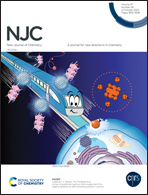Conversion of sawdust residuals to activated-carbon-supported pure nickel nanoparticles as a novel composite membrane for simultaneous hydrogen separation and storage†
Abstract
Hydrogen has recently become a prized resource to generate clean power owing to its massive energy content and harmless emissions produced during its combustion. However, other gases are always attached to hydrogen during its production via various routes. Therefore, the obtainment of hydrogen with high purity for use in energy production is generally questionable. In agreement with that goal, this study is directed toward the synthesis of activated-carbon-supported nickel nanoparticles as a novel composite membrane for hydrogen separation from gas mixtures. First, a type of solid residual (sawdust) was converted via thermochemical treatment into particles of activated carbon, which have enhanced surface properties. These carbon particles were then metalized by nickel nanoparticles using an electroless plating (ELP) technique. The obtained composite was subsequently turned into a disk-like membrane using hydraulic pressing, and was then thermally treated at high temperature to generate a dense-layered Ni membrane. Full characterization on a comparative basis between the blank and metalized carbon particles was carried out using X-ray diffraction (XRD), Fourier Transform infrared (FT-IR) spectroscopy, BET surface area analysis, transmission electron microscopy (TEM) and thermal gravimetric analysis (TGA). The efficiency of the Ni-based membrane toward H2 separation was next tested through the use of gas mixtures composed of different hydrogen-to-nitrogen concentrations. A maximum hydrogen flux and hydrogen-to-nitrogen selectivity of 15.16 sccm cm−2 min−1 and 465, respectively, were attained at ambient temperature. Additionally, a hydrogen permeability percentage of nearly 80% (from the original H2 stream) could be achieved by the designed Ni-membrane, which could offer synchronized hydrogen storage during the separation process.



 Please wait while we load your content...
Please wait while we load your content...